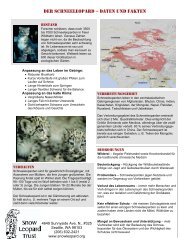Download the 7 Mb PDF file - Snow Leopard Trust
Download the 7 Mb PDF file - Snow Leopard Trust
Download the 7 Mb PDF file - Snow Leopard Trust
Create successful ePaper yourself
Turn your PDF publications into a flip-book with our unique Google optimized e-Paper software.
Engaging Students in Conservation<br />
24<br />
11. Continue investigating links among<br />
ecosystem components by asking<br />
students to identify which ecosystems<br />
members are connected to <strong>the</strong> individuals<br />
that were connected to <strong>the</strong> plants.<br />
Continue writing names and connecting<br />
food web components with arrows until<br />
all components are listed in a large food<br />
web. (See sample illustration below.)<br />
• Note: You will need to decide as a<br />
class where humans fit into <strong>the</strong> food<br />
web. One could argue that humans are<br />
at <strong>the</strong> top of <strong>the</strong> food web, since <strong>the</strong>y<br />
hunt snow leopards.<br />
domestic<br />
goat<br />
bharal<br />
snow leopard / human<br />
Chukar<br />
partridge<br />
grass / shrub<br />
12. (Optional) On your food web, include<br />
numbers of individuals from each species<br />
that participated in <strong>the</strong> mingle activity to<br />
indicate <strong>the</strong> available energy at various<br />
levels of <strong>the</strong> food web.<br />
13. Ask students to share one thing that<br />
comes to mind when <strong>the</strong>y see <strong>the</strong> web.<br />
(For example, most species are connected to<br />
ZUNDVIN NAMSHIR<br />
ibex marmot woolly<br />
hare<br />
Mountain Mixer<br />
many o<strong>the</strong>r species. Also, <strong>the</strong> food web would<br />
look very different without plants.)<br />
14. Remind students that <strong>the</strong> snow leopard<br />
is an endangered species, meaning that<br />
it is in danger of going extinct. Draw a<br />
large X through <strong>the</strong> snow leopard in <strong>the</strong><br />
food web, as if it no longer existed.<br />
15. In a class discussion or as a written<br />
exercise, ask students which species would<br />
be directly affected by <strong>the</strong> disappearance<br />
of snow leopards from <strong>the</strong> ecosystem.<br />
• How would each of <strong>the</strong>se species be<br />
affected in <strong>the</strong> short term?<br />
• Would <strong>the</strong>ir numbers increase or decrease?<br />
• How would each species be affected<br />
long-term, such as a year from now?<br />
16. Review <strong>the</strong> definition of keystone<br />
species with students. Tell <strong>the</strong>m that <strong>the</strong><br />
snow leopard is considered a keystone<br />
species because its presence in an<br />
ecosystem regulates <strong>the</strong> o<strong>the</strong>r types of<br />
species that are in that ecosystem.<br />
17. (Optional) Read about and discuss <strong>the</strong><br />
importance of o<strong>the</strong>r keystone species,<br />
such as wolves in North America. 1<br />
18. Discuss <strong>the</strong> contribution of all species<br />
to ecosystem biodiversity. To illustrate<br />
this idea, ask how <strong>the</strong> ecosystem would<br />
be affected if all of <strong>the</strong> woolly hares<br />
disappeared. (Likely <strong>the</strong>re would be more<br />
© FACING THE FUTURE www.facing<strong>the</strong>future.org & SNOW LEOPARD TRUST www.snowleopard.org<br />
2




